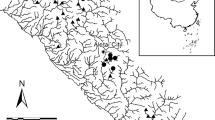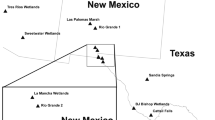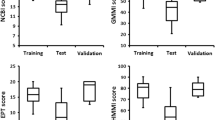Abstract
In an ongoing effort to propose biologically protective nutrient criteria, we examined how total nitrogen (TN) and its forms were associated with macroinvertebrate communities in wadeable streams of Maryland. Taxonomic and functional metrics of an index of biological integrity (IBI) were significantly associated with multiple nutrient measures; however, the highest correlations with nutrients were for ammonia-N and nitrite-N and among macroinvertebrate measures were for Beck’s Biotic Index and its metrics. Since IBI metrics showed comparatively less association, we evaluated how macroinvertebrate taxa related to proposed nutrient criteria previously derived for those same streams instead of developing nutrient–biology thresholds. We identified one tolerant and three intolerant taxa whose occurrence appeared related to a TN benchmark. Individually, these taxa poorly indicated whether streams exceeded the benchmark, but combining taxa notably improved classification rates. We then extracted major physiochemical gradients using principal components analysis to develop models that assessed their influence on nutrient indicator taxa. The response of intolerant taxa was predominantly influenced by a nutrient-forest cover gradient. In contrast, habitat quality had a greater effect on tolerant taxa. When taxa were aggregated into a nutrient sensitive index, the response was primarily influenced by the nutrient-forest gradient. Multiple lines of evidence highlight the effects of excessive nutrients in streams on macroinvertebrate communities and taxa in Maryland, whose loss may not be reflected in metrics that form the basis of biological criteria. Refinement of indicator taxa and a nutrient-sensitive index is warranted before thresholds in aquatic life to water quality are quantified.






Similar content being viewed by others
References
APHA. (1998). Standard methods for the examination of water and wastewater (20th ed.). Washington, DC: American Public Health Association.
Barbour, M. T., Gerritsen, J., Snyder, B. D., & Stribling, J. B. (1999). Rapid Bioassessment Protocols for Use in Streams and Wadeable Rivers: Periphyton, Benthic Macroinvertebrates and Fish, Second Edition. Washington, DC: EPA 841-B-99-002, USEPA, Office of Water.
Bernhardt, E. S., Palmer, M. A., Allan, J. D., Alexander, G., Barnas, K., Brooks, S., et al. (2005). Synthesizing US river restoration efforts. Science, 308, 636–637.
Bovee, K. D. (1986). Development and evaluation of habitat suitability criteria for use in the Instream Flow Incremental Methodology. Washington, DC: USDOI Fish and Wildlife Service Instream Flow Information Paper #21 FWS/OBS-86/7.
Bowman, M. F., Chambers, P. A., & Schindler, D. W. (2007). Constraints on benthic algal response to nutrient addition in oligotrophic mountain rivers. River Research and Applications, 23, 858–876.
Burnham, S. E., & Anderson, D. R. (2002). Model selection and multimodel inference: a practical information-theoretic approach. New York: Springer.
Cade, N. S., Terrell, J. W., & Schroeder, R. L. (1999). Estimating effects of limiting factors with regression quartiles. Ecology, 80, 311–323.
Camgaro, J. A., & Alonso, A. (2006). Ecological and toxicological effects of inorganic nitrogen pollution in aquatic ecosystems: a global assessment. Environment International, 32, 831–849.
Castro, M. S., Driscoll, C. T., Jordan, T. E., Reay, W. G., & Boyton, W. R. (2003). Sources of nitrogen to estuaries in the United States. Estuaries, 26, 803–814.
Chambers, P. A., Vis, C., Brua, R. B., Guy, M., & Culp, J. M. (2008). Eutrophication of agricultural streams: defining nutrient concentrations to protect ecological condition. Water Science and Technology, 58, 2203–2210.
Cole, R. A. (1973). Stream community response to nutrient enrichment. Journal of the Water Pollution Control Federation, 45, 1874–1888.
Cooper, C. M. (1993). Biological effects of agriculturally-derived surface water pollutants on aquatic systems—a review. Journal of Environmental Quality, 22, 402–408.
Cross, W. F., Wallace, J. B., Rosemond, A. D., & Eggert, S. L. (2006). Whole-system nutrient enrichment increases secondary production in a detritus-based ecosystem. Ecology, 87, 1556–1565.
Dodds, W. K., & Welch, E. B. (2000). Establishing nutrient criteria in streams. Journal of the North American Benthological Society, 19, 186–196.
Dodds, W. K., Bouska, W. W., Eitzmann, J. L., Pilger, T. L., Pitts, K. L., Riley, A. J., et al. (2009). Eutrophication of U.S. freshwaters: analysis of potential economic damages. Environmental Science and Technology, 43, 12–19.
Driscoll, C., Whithall, D., Aber, J., Boyer, E., Castro, M., Cronan, C., et al. (2003). Nitrogen pollution: sources and consequences in the US Northeast. Environment, 45, 9–21.
Easton, G. S., & McCulloch, R. E. (1990). A multivariate generalization of quantile–quantile plots. Journal of the American Statistical Association, 85, 376–386.
Evans-White, M. A., Dodds, W. K., Huggins, D. A., & Baker, D. S. (2009). Thresholds in macroinvertebrate biodiversity and stoichiometry across water-quality gradients in Central Plains (USA) streams. Journal of the North American Benthological Society, 28, 855–868.
Galloway, J. N., Aber, J. D., Erisman, J. W., Seitziner, S. S., Howarth, R. W., Cowling, E. B., et al. (2003). The nitrogen cascade. BioScience, 53, 341–356.
Heisler, J., Glibert, P. M., Burkholder, J. M., Anderson, D. M., Cochlan, W., Dennison, W. C., et al. (2008). Eutrophication and harmful algal blooms: a scientific consensus. Harmful Algae, 8, 3–13.
Hilsenhoff, W. L. (1987). An improved biotic index of organic stream pollution. The Great Lakes Entomologist, 20, 31–40.
Homer, C. C., Dewitz, J., Fry, J., Coan, M., Hossain, N., Larson, C., et al. (2007). Completion of the 2001 National Landcover database for the conterminous United States. Photogrammetric Engineering and Remote Sensing, 73, 337–341.
Jackson, D. A. (1993). Stopping rules in principal components analysis: a comparison of hueristical and statistical approaches. Ecology, 74, 2204–2214.
Karr, J. R., & Chu, E.W. (1997). Biological monitoring and assessment: using multimetric indexes effectively. University of Washington.
Kazyak, P. F. (2000). Maryland biological stream survey sampling manual. Monitoring and Non-Tidal Assessment Division, Maryland Department of Natural Resources.
Kemp, W. M., Boyton, W. R., Adolf, J. E., Doesch, D. E., Boicourt, W. C., Brush, G., et al. (2005). Eutrophication of Chesapeake Bay: historical trends and ecological interactions. Marine Ecology Progress Series, 303, 1–29.
King, R. S., & Richardson, C. J. (2003). Integrating bioassessment and ecological risk assessment: an approach to developing numerical water-quality criteria. Environmental management, 31, 795–809.
King, R. S., Baker, M. E., Kazyak, P. F., & Weller, D. E. (2011). How novel is too novel? Stream community thresholds at exceptionally low levels of catchment urbanization. Ecological applications, 21, 1659–78.
Klauda, R., Kazyak, P., Stranko, S., Souterland, M., Roth, N., & Chaillou, J. (1998). Maryland Biological Stream Survey: a state agency program to assess the impact of anthropogenic stress on stream habitat quality and biota. Environmental Monitoring and Assessment, 51, 299–316.
MacCullagh, P., & Nelder, J. A. (1989). Generalized linear models (2nd ed.) CRC.
McCune, B., & Grace, J. B. (2002). Analysis of ecological communities. MJM Software Design.
MDLS. (2008). Chesapeake Bays and Atlantic Coastal Bays 2010 trust fund and non-point source fund. Annapolis: Maryland General Assembly, Senate Bill 213.
Meador, M. R. (2012). Nutrient enrichment and fish nutrient tolerance: assessing biologically relevant nutrient criteria. Journal of the American Water Resources Association, 49, 253–263.
Miltner, R. J. (2010). A method and rationale for deriving nutrient criteria for small rivers and streams in Ohio. Environmental Management, 45, 842–845.
Miltner, R. J., & Rankin, E. T. (1998). Primary nutrients and the biotic integrity of rivers and streams. Freshwater Biology, 40, 145–158.
Morgan, R. P., & Kline, K. M. (2011). Nutrient concentrations in Maryland non-tidal streams. Environmental Monitoring and Assessment, 178, 221–235.
Palmer, M. A. (2009). Reforming watershed restoration: science in need of application and applications in need of science. Estuaries and Coasts, 32, 1–17.
Paul, J. F., & McDonald, M. E. (2005). Development of empirical, geographically specific water quality criteria: a conditional probability analysis approach. Journal of the American Water Resources Association 41, 1211–1223.
Peterson, B., Fry, B., Deegan, L., & Hershey, A. (1993). The trophic significance of epilithic algal production in a fertilized tundra river ecosystem. Limnology and Oceanography, 28, 872–878.
Peterson, B., Wollheim, W., Mulholland, P., Webster, J., Meyer, J., Tank, J., et al. (2001). Control of nitrogen export from watersheds by headwater streams. Science, 292, 86–90.
Poff, N. L. (1997). Landscape filters and species traits: towards mechanistic understanding and prediction in stream ecology. Journal of the North American Benthological Society, 16, 391–409.
Poff, N. L., & Ward, J. V. (1989). Implications of streamflow variability and predictability for lotic community structure: a regional analysis of streamflow patterns. Canadian Journal of Fisheries and Aquatic Sciences, 46, 1805–1818.
Poff, N. L., & Ward, J. V. (1990). The physical habitat template of lotic systems: recovery in the context of historical pattern of spatio-temporal heterogeneity. Environmental Management, 14, 629–646.
Poff, N. L., Olden, J. D., Vieira, N. K., Finn, D. S., Simmons, M. P., & Kondratieff, B. C. (2006). Functional trait niches of North American lotic insects: traits-based ecological applications in light of phylogenetic relationships. Journal of the North American Benthological Society 25, 730–755.
R Development Core Team. (2012). R: A language and environment for statistical computing. R Foundation for Statistical Computing, Vienna, Austria. http://www.R-project.org/. Accessed 25 Oct 2012
Richards, C., Host, G. E., & Arthur, J. W. (1993). Identification of predominant environmental factors structuring stream macroinvertebrate communities within a large agricultural catchment. Freshwater Biology, 29, 285–294.
Richards, C., Johnson, L. B., & Host, G. E. (1996). Landscape-scale influences on stream habitats and biota. Canadian Journal of Fisheries and Aquatic Sciences, 53(S1), 295–311.
Smith, V. H., Tilman, G. D., & Nekola, J. C. (1999). Eutrophication: impacts of excess nutrient inputs on freshwater, marine, and terrestrial ecosystems. Environmental Pollution, 100, 179–196.
Smith, A. J., Bode, R. W., & Kleppel, G. S. (2007). A nutrient biotic index (NBI) for use with benthic macroinvertebrate communities. Ecological Indicators, 7, 371–386.
Southerland, M. T., & Stribling, J. P. (1995). Status of biological criteria development and implementation pp. In W. S. Davis & T. P. Simon (Eds.), Biological assessment and criteria: tools for water resource planning and decision making (pp. 81–96). Boca Raton: Lewis Publishers.
Southerland, M. T., Rogers, G. M., Kline, K. M., Morgan, R. P., Boward, D. M., Kazyak, P. F., et al. (2007). Improving biological indicators to better assess the condition of streams. Ecological Indicators, 7, 751–767.
Southerland, M. T., Vǿlstad, J. H., Weber, E. D., Klauda, R. J., Poukish, C. A., & Rowe, M. C. (2009). Application of the probability-based Maryland Biological Stream Survey to the state’s assessment of water quality standards. Environmental Monitoring and Assessment, 150, 65–73.
Stone, M. L., Whiles, M. R., Webber, J. A., Willard, K. W. J., & Reeve, J. D. (2005). Macroinvertebrate communities in agriculturally impacted Southern Illinois streams: patterns with riparian vegetation, water quality, and in-stream habitat quality. Journal of Environmental Quality, 34, 907–917.
Stranko, S. A., Hurd, M. W., & Klauda, R. J. (2005). Applying a large, statewide database to the assessment, stressor diagnosis, and restoration of stream fish communities. Environmental Monitoring and Assessment, 108, 99–121.
Suplee, M. W., Varghese, A., & Cleland, J. (2007). Developing nutrient criteria for streams: an evaluation of the frequency distribution method. Journal of the American Water Resources Association, 43, 453–472.
Trebitz, A. S. (2012). Deriving criteria-supporting benchmark values from empirical response relationships: comparison of statistical techniques and effect of log-transforming the nutrient variable. Freshwater Science, 31, 986–1002.
USEPA. (1987). Handbook of methods for acid deposition studies: laboratory analyses for surface water chemistry. Washing, DC: USEPA, Office of Acid Deposition, Environmental Monitoring and Quality Assurance.
USEPA. (1999). Update of ambient water quality criteria for ammonia. Washington, DC: EPA-822-R-99-014, USEPA, Office of Water, Office of Science and Technology.
USEPA. (2000a). Nutrient criteria technical guidance manual: Rivers and streams. Washington, DC: EPA-822-B-00-002, USEPA, Office of Water, Office of Science and Technology.
USEPA. (2000b). Ambient water quality recommendations, rivers and streams in nutrient ecoregion XI. Washington, DC: EPA-822-B-00-019, USEPA, Office of Water, Office of Science and Technology.
USEPA. (2010a). Using Stressor–response relationships to derive numeric nutrient criteria. Washington, DC: EPA-820-S-10-001, USEPA, Office of Water, Office of Science and Technology.
USEPA. (2010b). Establishment of the total maximum daily load for the Chesapeake Bay. Washington, DC: EPA-R03-OW-2010-0736-0776, USEPA, Office of Water, Office of Science and Technology.
Utz, R. M., Hildebrand, R. H., & Boward, D. A. (2009). Identifying regional differences in threshold responses of aquatic invertebrates to landcover gradients. Ecological indicators, 9, 556–567.
Wang, L., Roberston, D. M., & Garrison, S. F. (2007). Linkages between nutrients and assemblages of macroinvertebrates and fish in wadeable streams: implications to nutrient criteria development. Environmental Management, 39, 194–212.
Ward, J. V., & Stanford, J. A. (1992). Thermal responses in the evolutionary ecology of aquatic insects. Annual Review of Entomology, 27, 97–117.
Weigel, B. M., & Robertson, D. M. (2007). Identifying biotic integrity and water chemistry relations in non-wadeable rivers of Wisconsin: toward the development of nutrient criteria. Environmental Management, 40, 691–708.
Zheng, L., Gerritsen, J., Beckman, J., Ludwig, J., & Wilkes, S. (2008). Land use, geology, enrichment, and stream biota in the eastern ridge and valley ecoregion: implications for nutrient criteria development. Journal of the American Water Resources Association, 44, 1521–1536.
Acknowledgments
We thank all personnel associated with the MDNR’s Maryland Biological Stream Survey, University of Maryland Appalachia Lab, and Versar, Inc. for their assistance in field data collection and excellent stream monitoring database. We are especially indebted to Ellen Friedman, Neal Dziepak, and others who processed and identified macroinvertebrate community samples. Thoughtful discussion was provided by Dan Boward and Patrick Graves.
Author information
Authors and Affiliations
Corresponding author
Rights and permissions
About this article
Cite this article
Ashton, M.J., Morgan, R.P. & Stranko, S. Relations between macroinvertebrates, nutrients, and water quality criteria in wadeable streams of Maryland, USA. Environ Monit Assess 186, 1167–1182 (2014). https://doi.org/10.1007/s10661-013-3447-1
Received:
Accepted:
Published:
Issue Date:
DOI: https://doi.org/10.1007/s10661-013-3447-1




